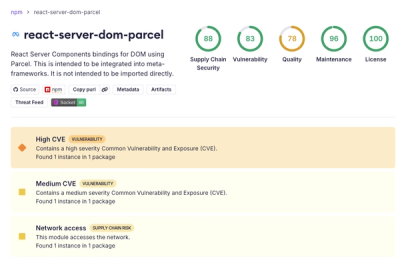
Security News
Deno 2.6 + Socket: Supply Chain Defense In Your CLI
Deno 2.6 introduces deno audit with a new --socket flag that plugs directly into Socket to bring supply chain security checks into the Deno CLI.
websocket-client
Advanced tools
websocket-client is a WebSocket client for Python. It provides access to low level APIs for WebSockets. websocket-client implements version hybi-13 of the WebSocket protocol. This client does not currently support the permessage-deflate extension from RFC 7692.
This project's documentation can be found at https://websocket-client.readthedocs.io/
Please see the contribution guidelines
You can use pip install websocket-client to install, or pip install -e .
to install from a local copy of the code. This module is tested on Python 3.8+.
There are several optional dependencies that can be installed to enable specific websocket-client features.
python-socks for proxy usage and wsaccel for a minor performance boost, use:
pip install websocket-client[optional]websockets to run unit tests using the local echo server, use:
pip install websocket-client[test]Sphinx and sphinx_rtd_theme to build project documentation, use:
pip install websocket-client[docs]While not a strict dependency, rel
is useful when using run_forever with automatic reconnect. Install rel with pip install rel.
Footnote: Some shells, such as zsh, require you to escape the [ and ] characters with a \.
Check out the documentation's FAQ for additional guidelines: https://websocket-client.readthedocs.io/en/latest/faq.html
Known issues with this library include lack of WebSocket Compression support (RFC 7692) and minimal threading documentation/support.
The send and validate_utf8 methods can sometimes be bottleneck.
You can disable UTF8 validation in this library (and receive a
performance enhancement) with the skip_utf8_validation parameter.
If you want to get better performance, install wsaccel. While
websocket-client does not depend on wsaccel, it will be used if
available. wsaccel doubles the speed of UTF8 validation and
offers a very minor 10% performance boost when masking the
payload data as part of the send process. Numpy used to
be a suggested performance enhancement alternative, but
issue #687
found it didn't help.
Many more examples are found in the examples documentation.
Most real-world WebSockets situations involve longer-lived connections.
The WebSocketApp run_forever loop will automatically try to reconnect
to an open WebSocket connection when a network
connection is lost if it is provided with:
dispatcher argument (async dispatcher like rel or pyevent)reconnect argument (delay between disconnection and attempted reconnection)run_forever provides a variety of event-based connection controls
using callbacks like on_message and on_error.
run_forever does not automatically reconnect if the server
closes the WebSocket gracefully (returning
a standard websocket close code).
This is the logic behind the decision.
Customizing behavior when the server closes
the WebSocket should be handled in the on_close callback.
This example uses rel
for the dispatcher to provide automatic reconnection.
import websocket
import _thread
import time
import rel
def on_message(ws, message):
print(message)
def on_error(ws, error):
print(error)
def on_close(ws, close_status_code, close_msg):
print("### closed ###")
def on_open(ws):
print("Opened connection")
if __name__ == "__main__":
websocket.enableTrace(True)
ws = websocket.WebSocketApp("wss://api.gemini.com/v1/marketdata/BTCUSD",
on_open=on_open,
on_message=on_message,
on_error=on_error,
on_close=on_close)
ws.run_forever(dispatcher=rel, reconnect=5) # Set dispatcher to automatic reconnection, 5 second reconnect delay if connection closed unexpectedly
rel.signal(2, rel.abort) # Keyboard Interrupt
rel.dispatch()
This is if you want to communicate a short message and disconnect immediately when done. For example, if you want to confirm that a WebSocket server is running and responds properly to a specific request.
from websocket import create_connection
ws = create_connection("ws://echo.websocket.events/")
print(ws.recv())
print("Sending 'Hello, World'...")
ws.send("Hello, World")
print("Sent")
print("Receiving...")
result = ws.recv()
print("Received '%s'" % result)
ws.close()
FAQs
WebSocket client for Python with low level API options
We found that websocket-client demonstrated a healthy version release cadence and project activity because the last version was released less than a year ago. It has 3 open source maintainers collaborating on the project.
Did you know?

Socket for GitHub automatically highlights issues in each pull request and monitors the health of all your open source dependencies. Discover the contents of your packages and block harmful activity before you install or update your dependencies.

Security News
Deno 2.6 introduces deno audit with a new --socket flag that plugs directly into Socket to bring supply chain security checks into the Deno CLI.

Security News
New DoS and source code exposure bugs in React Server Components and Next.js: what’s affected and how to update safely.

Security News
Socket CEO Feross Aboukhadijeh joins Software Engineering Daily to discuss modern software supply chain attacks and rising AI-driven security risks.